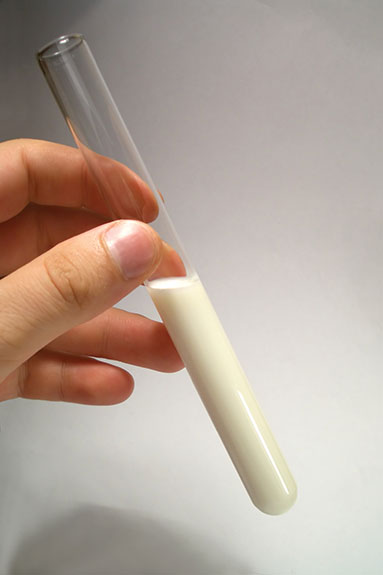Although some dairy producers have a tried and true method of pregnancy diagnosis on their dairies, new and emerging technologies are in the works to help improve efficiency in this area of the reproductive program. In the fall of 2012, milk-based pregnancy tests joined rectal palpation, transrectal ultrasonography and blood-based pregnancy tests as a tool to determine whether a cow is pregnant.
However, before producers begin to adapt new testing technology, they must weigh whether the new product will have a fit in their reproductive management and overall herd management system. Because the success of dairy reproduction programs rely on confirming pregnancies, detecting open cows earlier and shortening the calving interval, these tools can help lessen the economic impact of increased open days on the dairy.
About this technology
The purpose of these new milk-based pregnancy tests are not to simply detect those dairy cows that are pregnant but to confirm which cows are open in a timely manner. This new test does not replace other alternatives to diagnose pregnancies but does provide producers with another option in confirming pregnancies within their herds.
Similar to blood-based pregnancy tests, once samples are obtained – in this case, milk samples – they are sent to laboratories where an enzyme-linked immunosorbent assay (ELISA) is performed. The assay for this pregnancy test detects the concentration of pregnancy-associated glycoproteins (PAGs) to determine the pregnancy status of a cow. Both tests show a high level of accuracy when samples are taken 35 days or more after breeding.
In partnership with Antel BioSystems , Maine-based IDEXX Laboratories announced the release of its test – the IDEXX Milk Pregnancy Test – at World Dairy Expo in October. Also in early October, Portland-based Animal Profiling International, Inc. (API) announced the launch of EasyPreg, its milk-based pregnancy testing service.
From sample collection to results
Both milk-based tests follow similar procedures from sample collection to the return of results. To use the EasyPreg test, samples must first be collected following the instructions given by API. The samples must then be shipped to an API laboratory where they will be tested. Once the results are ready, they are reported either directly to the producer and/or the dairy farm’s veterinarian.
As far as the IDEXX milk-based test, producers have the option of expanding the use of DHI milk samples and integrating this pregnancy test into their current DHI testing program. According to AntelBio, kits to run the test were made commercially available to DHI organizations across the U.S. on October 1. NorthStar Cooperative , the parent company of AntelBio, began offering the milk pregnancy test to dairy producers in the Midwest on November 1. In working with Dairy Herd Improvement organizations, this IDEXX test can confirm if an animal is pregnant or open in less than 3.5 hours.
Accuracy of this test
In research conduct by IDEXX, one factor does stand out in terms of the use of milk pregnancy tests – the relationship between when the test is done and the sensitivity and specificity of test results within a given time frame in the cow’s gestation period.
According to the research, 1,315 field samples were analyzed to determine the sensitivity and specificity of this test. When the samples were taken between 35 days and 55 days after breeding, the sensitivity of the IDEXX test was 97.5 percent with a specificity of 92.2 percent.
The sensitivity and specificity of the test increased between 56 and 75 days after breeding to 97.8 percent and 100 percent, respectively. It was not until after 75 days post-breeding that the sensitivity level of the test reached its highest point at 99.4 percent.
In the research, the accuracy of the animals considered pregnant by the milk test was reviewed by following up the test with transrectal ultrasound at least 28 days post-breeding or by palpation performed after 50 days of gestation.

Benefits of this test
From a cow-handling aspect, the use of milk-based pregnancy tests reduces the amount of stress on the animal. The milk samples can be taken in the parlor without the need of special training for employees. In contrast to blood-based pregnancy tests, taking these samples does not require the use of needles to collect samples.
Because the samples can be taken in the parlor, cows also do not have to be locked up, eliminating additional disruptions in the cow’s resting and eating time. This milk-based test method provides a non-invasive way of confirming a pregnancy, while eliminating additional labor requirements of other pregnancy diagnosis methods.
Additionally, producers can develop protocols that work for their individual operations, taking into consideration time frame and frequency at which milk samples are taken for pregnancy detection.
Milk-based tests vs. other methods
Idaho-based BioTracking, LLC developed the blood-based pregnancy test BioPRYN, which is currently being used on dairy operations across the country.
This test measures the presence of pregnancy-specific protein B (PSPB), a protein only produced by the placenta of a growing fetus, in the blood circulation of the animal. In using the blood-based test to obtain the higher accuracy, cows and heifers must be at least 28 days or later post-breeding and cows must be at least 73 days post-calving.
In the research conducted by IDEXX, when the milk-based tests were compared to blood-based tests from 216 samples, the overall agreement between the two tests was 98.4 percent. However, 18 samples from the confirmed pregnant cow population were designated as recheck on the milk test and pregnant on the blood; these samples were excluded from the determination of the agreement between the two tests.
According to BioTracking, the blood-based test produces 99 percent accuracy in detecting open cows. In research conducted by this company, the blood-based test had a higher sensitivity earlier – greater than 99 percent at 28 days post-breeding and throughout the pregnancy.
As with milk-based pregnancy tests, producers and managers have the flexibility to schedule the collection of blood samples at times that agree with their schedules. The results from these blood tests can be downloaded as an electronic report in a dairy management program.
Another milk monitoring tool
With the release of these two milk-based pregnancy tests, many may think that using milk as a medium to diagnose pregnancies is a new concept. However, Swedish company DeLaval, Inc . has been monitoring progesterone levels in milk through its Herd Navigator analyzer system to determine an animal’s reproduction status.
In addition to determining if a cow is pregnant (sustained levels of high progesterone), some producers use this system as a heat detection aid in pinpointing the optimal breeding time for an animal. Among other functions, Herd Navigator can also test milk samples for ketosis and mastitis.
Also, because the samples are collected and sent to an on-site analyzer, this tool serves as an on-farm laboratory, unlike milk-based pregnancy tests where samples are collected and sent to off-site laboratories.
Although Herd Navigator is not currently commercially available in the U.S., it is on its way to being launched. In September, Herd Navigator was launched commercially in Canada. Plans are currently under way to install the system on reference farms in the U.S.
Whether you are wanting to improve your reproductive program or just interested in the latest technologies available, milk testing can now provide you with more than just herd health information. However, there are still factors producers must keep in mind regarding milk-based pregnancy tests, such as comparing the benefits of these new tests to the costs associated of implementing the technology. It is up to you, as the producer, to determine if milk-based pregnancy tests are a fit for your operation. PD
Click here to read a cost comparison regarding the use of the EasyPreg and IDEXX milk pregnancy tests as opposed to other pregnancy detection methods in the Jan. 30 Progressive Dairyman Extra e-newsletter.
PHOTO: Milk-based pregnancy tests. Photo courtesy of Thinkstock.

-
Dario Martinez
- Editor
- Progressive Dairyman magazine
- Email an editor







